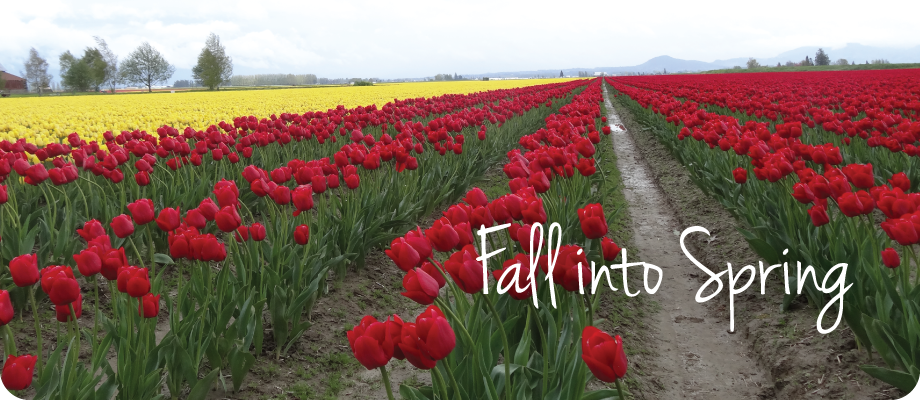
by Susan | Oct 17, 2014 | garden travel, gardening, plants
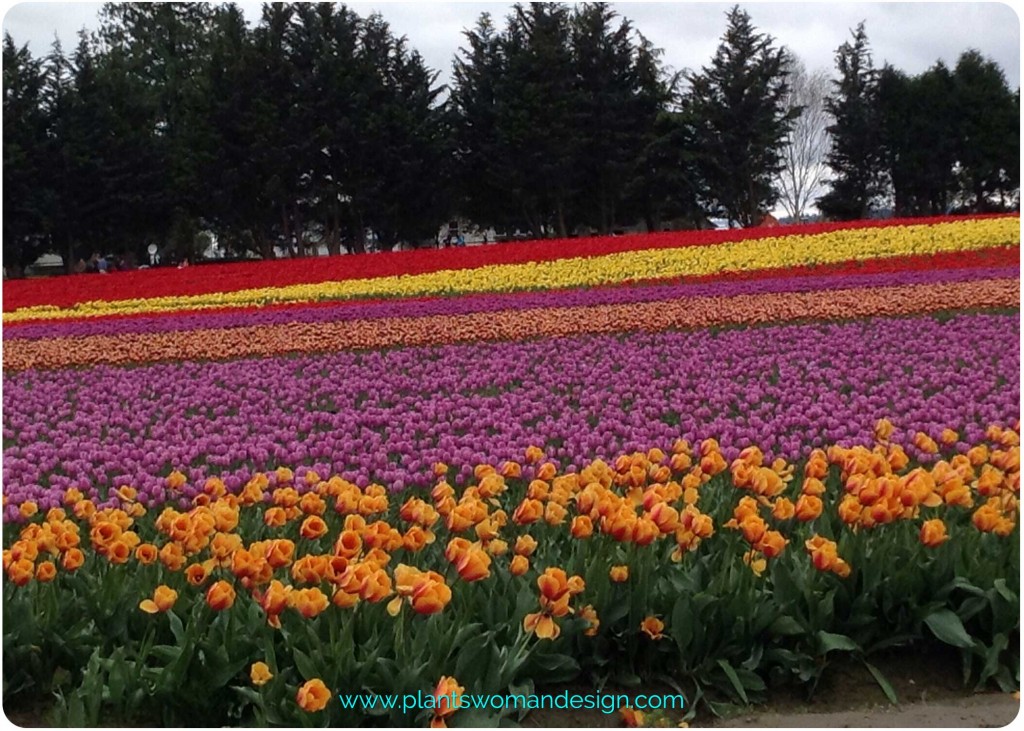 Remember the blog post from this past spring when I visited the tulip fields in Mt Vernon? They had the most spectacular display gardens, I took lots of pictures, you can read about it HERE. Now is the time to order. September through December you can pick bulbs from the list at www.tulips.com and they will send them off to you. I was not ready to pre-order last spring because I didn’t know where I was going to be. Now I’m ready and I’m going back through the pictures I took to get the labels. If I find a tulip I like I take a picture of the tulip up close and then a picture of the label. I try to always keep them in order so I can see which goes with that but it isn’t hard to figure out if you get mixed up. They have lots to choose from. Remember deer love tulips so if you have lots of 4 hoofed friends choose either daffodils (narcissus) or Allium bulbs. They are not on the favorite food list.
Remember the blog post from this past spring when I visited the tulip fields in Mt Vernon? They had the most spectacular display gardens, I took lots of pictures, you can read about it HERE. Now is the time to order. September through December you can pick bulbs from the list at www.tulips.com and they will send them off to you. I was not ready to pre-order last spring because I didn’t know where I was going to be. Now I’m ready and I’m going back through the pictures I took to get the labels. If I find a tulip I like I take a picture of the tulip up close and then a picture of the label. I try to always keep them in order so I can see which goes with that but it isn’t hard to figure out if you get mixed up. They have lots to choose from. Remember deer love tulips so if you have lots of 4 hoofed friends choose either daffodils (narcissus) or Allium bulbs. They are not on the favorite food list.
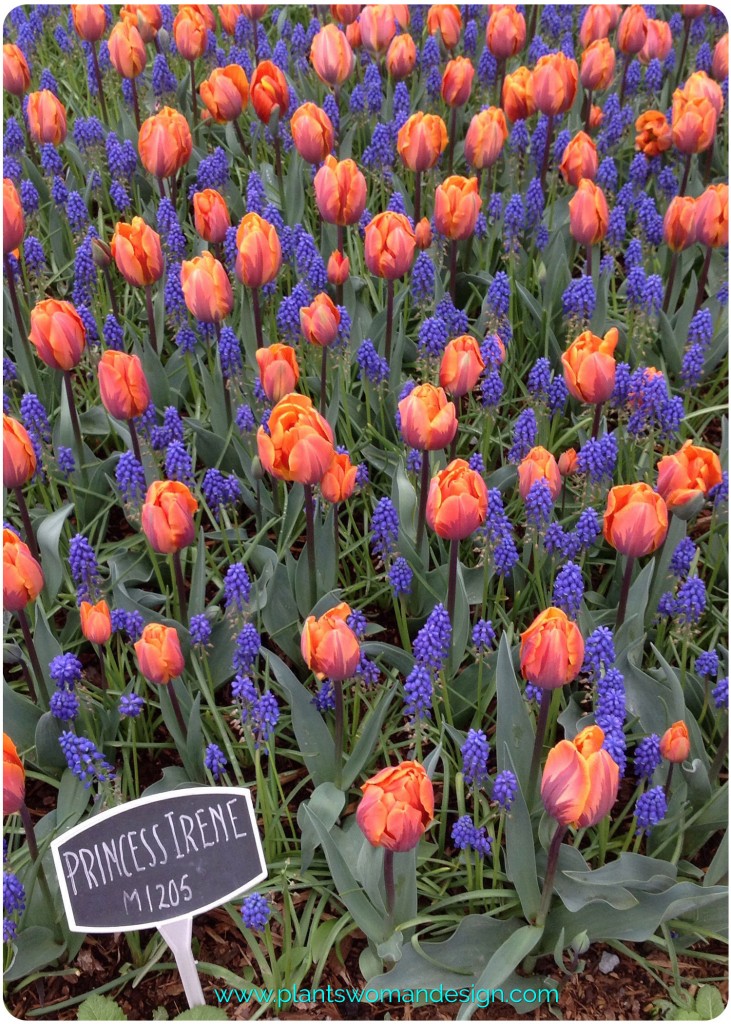
I discovered the difference in these bulbs last year. For the garden show I got quite a few bulbs online from another company and got a 20% successful force rate. That is horrible. Another designer had forced bulbs from Roozengarde and they were absolutely stunning. OK…. Buy Local!!
Are you planning on planting bulbs? What varieties have tickled your fancy this year?
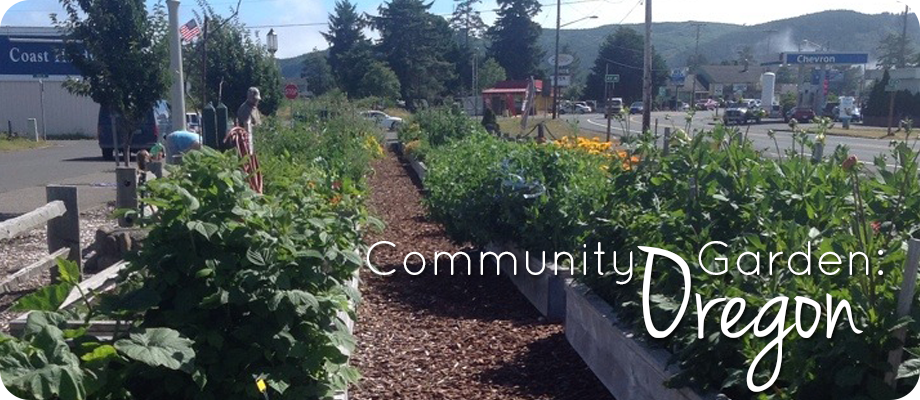
by Susan | Jul 24, 2014 | garden food, Traveling Plantswoman
I’m not sure if this should be a ‘Traveling Plantswoman” post or not. I was traveling with my sister and her friend and I don’t usually visit many gardens when I travel with other folks. We normally focus hiking, golfing, and hot tubbig so as not to bore my companions with ‘Garden Stuff’, however, it is never far from my thoughts. As we were driving to do one of the ‘sanctioned’ activities I just couldn’t help myself this time. I hollered “Sorry…. I have to”. There on the side of the road was an abundance of raised beds and lush plants. It was between the busy 101 hwy and another road and there was a rail car at one end and beautiful gardens. We pulled into a parking space and spotted a family harvesting and planting so, of course, I had to talk to them and see what this garden was all about.
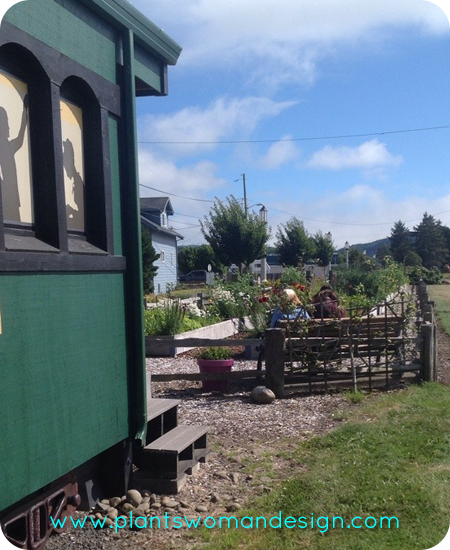
Frank and his wife Jennifer and their three kids were working in the garden. I was excited to see someone and to get a chance to ask them about the garden. They had just harvested a bag of onions and Jennifer had broken off the tops to give to the kids. These were little kids and they were eating them like celery or carrots and really enjoying them. They had a new crop of lettuce just planted and little baby radishes were almost ready to pick.
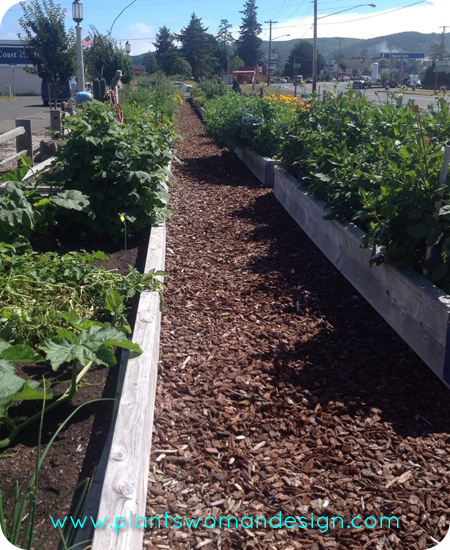 Fred took time to explain how they came to be there. They were a low income family who had used one of the scholarships to get a plot. They knew the two people on either side of their plot and they shared the produce. They were excited about teaching their children where food came from.
Fred took time to explain how they came to be there. They were a low income family who had used one of the scholarships to get a plot. They knew the two people on either side of their plot and they shared the produce. They were excited about teaching their children where food came from.
The family had not had a garden before but said they had help from other people in the community garden. They could email if they had a question and usually got a quick response. It was surprising how easy it was to grow vegs. They had a few problems that were unexpected. One problem they face is deer. How those beasties found this garden between two busy roads is amazing. But I guess if you plant it they will come. The other problem is thieves. I was surprised!
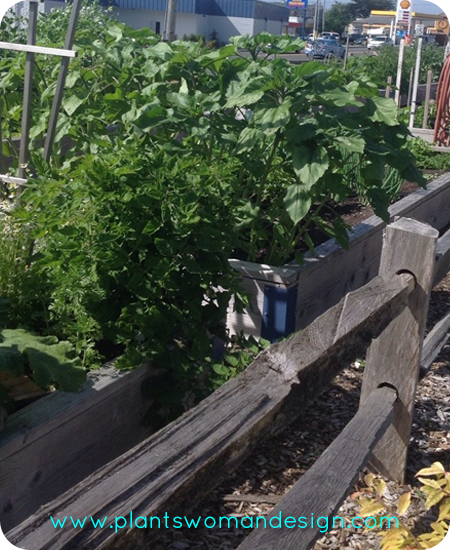
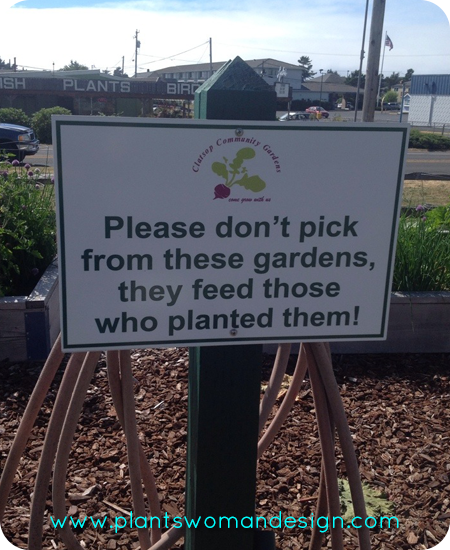

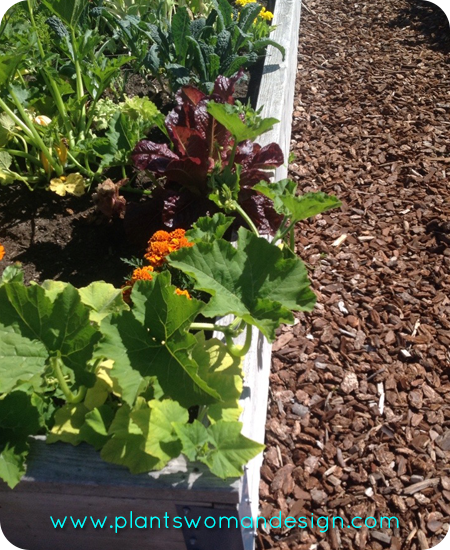
Community gardens can be anywhere and this garden clearly exemplifies that. We’ve had a couple of community garden posts (Albany Park, Albany Park #2 and Peterson) and we are glad to add this one to our list. It is exciting that more and more parents and communities want to help connect kids with “where food came from”.
Have you found a local community garden? Send us pictures!!! We want to see it.
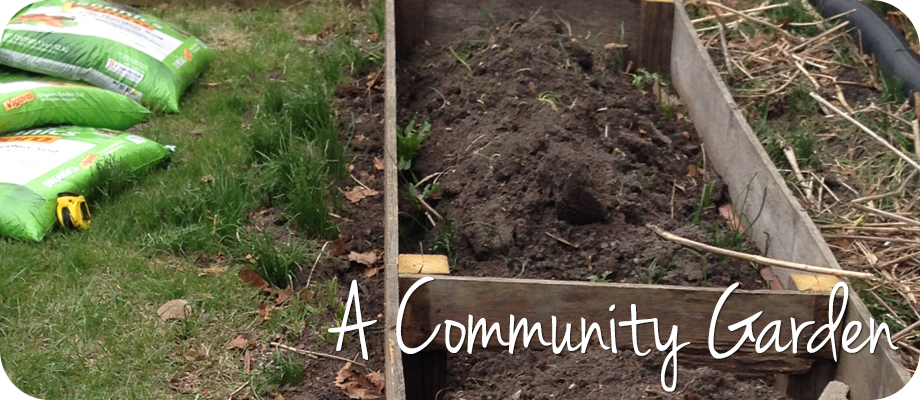
by Kristen | Jun 6, 2014 | garden travel
We found out a few months ago that the college my husband attends has a community garden! Due to the transient nature of the college the garden goes through cycles of tended and not. It just so happens that a few friends of ours were interested in tending the garden during their time at the college and invited us to join in the fun. There are numerous garden opportunities in the Chicago area and I’m excited to be a part of one that’s just down the block from us.
We started back in early May prepping the beds.
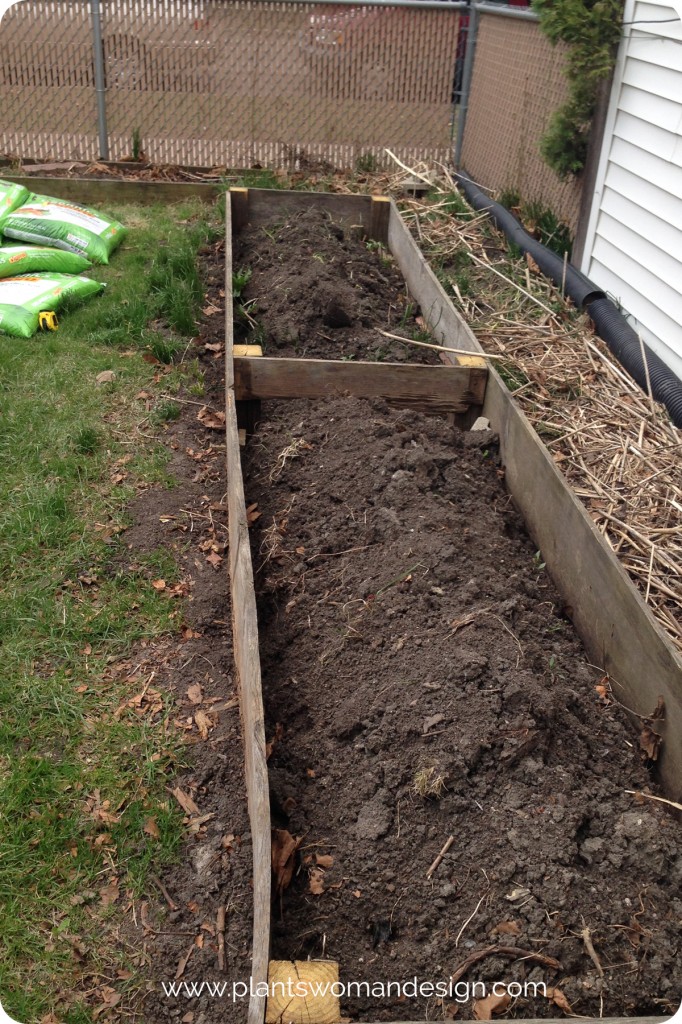

Our plan is to reclaim both large beds that flank the fence line on both sides, install a new raised bed for pole beans and fix up the existing raised bed. Currently we have tomato and basil starts ready to go in along with our pumpkin starts I wrote about a few days ago. Of the three families that are involved none of us claim to be “experts”. I’m excited to see what we are able to accomplish in the community garden this year.
What have you got growing so far?
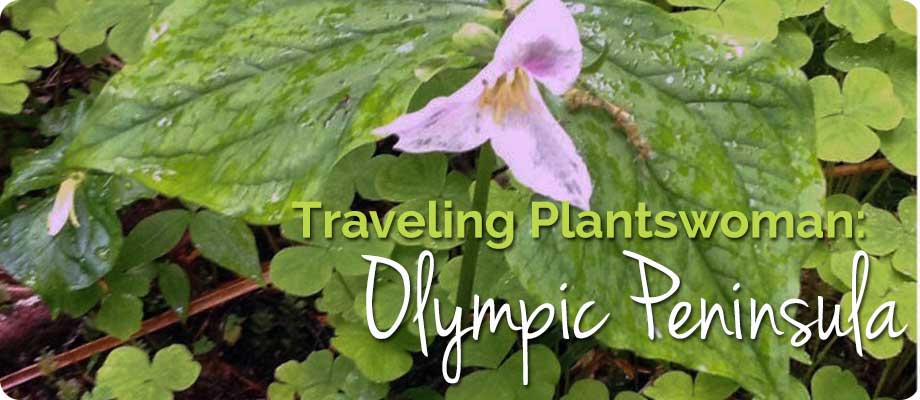
by Susan | May 7, 2014 | garden travel, Traveling Plantswoman
This weekend I ‘ran away from home’ again to the Soleduc River in the Olympic National forest. It was an unbelievably beautiful weekend with a mix of sun and showers. Though it was not warm, Spring was still in evidence and showing all the fresh green that we so look for after winter. This is the time that the leaves are coming out and they are so light green they seem to glow in the forest. Later in the year the same trees are various colors of green but never as vibrant as they are right now. By the time summer winds around they are tired and saturated colors of green change to bright yellows and oranges throughout the fall. In the Pacific Northwest we have a lot of evergreens but we also have a million shades of green.
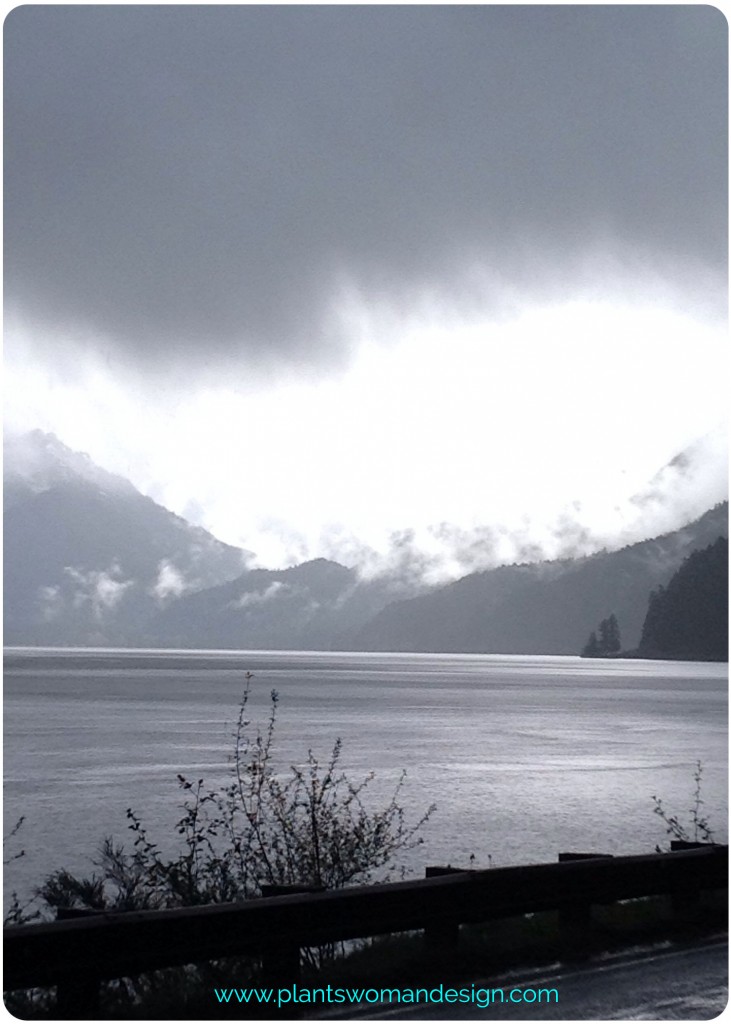
Can you spot the new snow on the peaks? It was 41 at the river this morning after a couple of days of 48 – 52 degrees. It doesn’t stop the relentless march of spring.
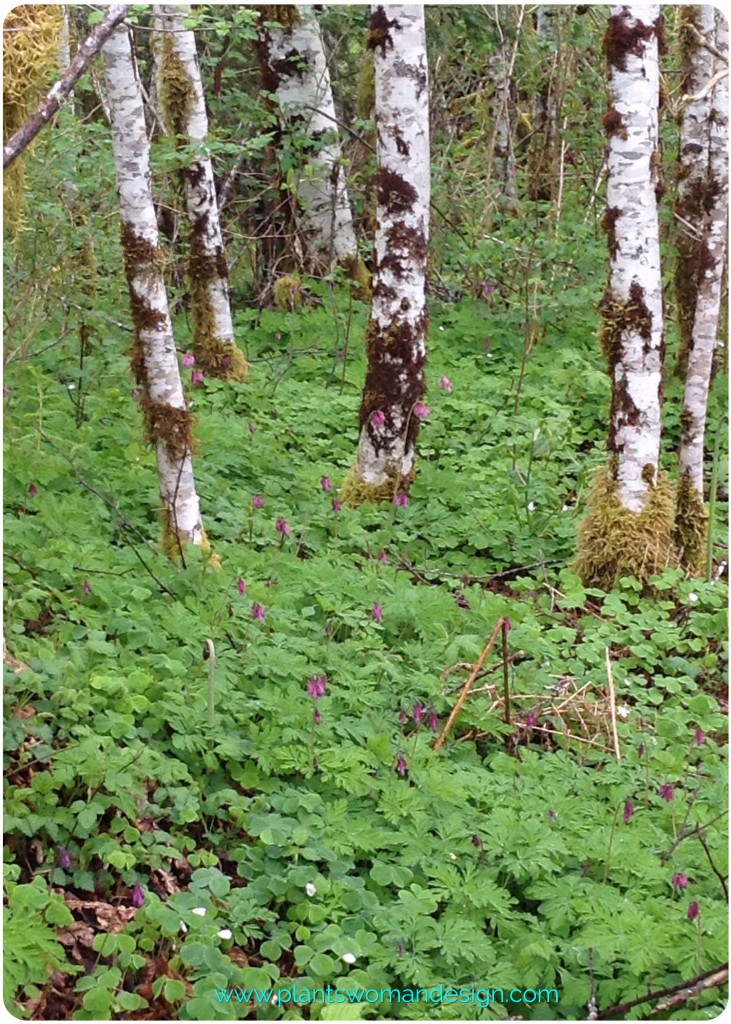
Trails through the woods have unrehearsed vignettes to view, proving that nature can be the best teacher.
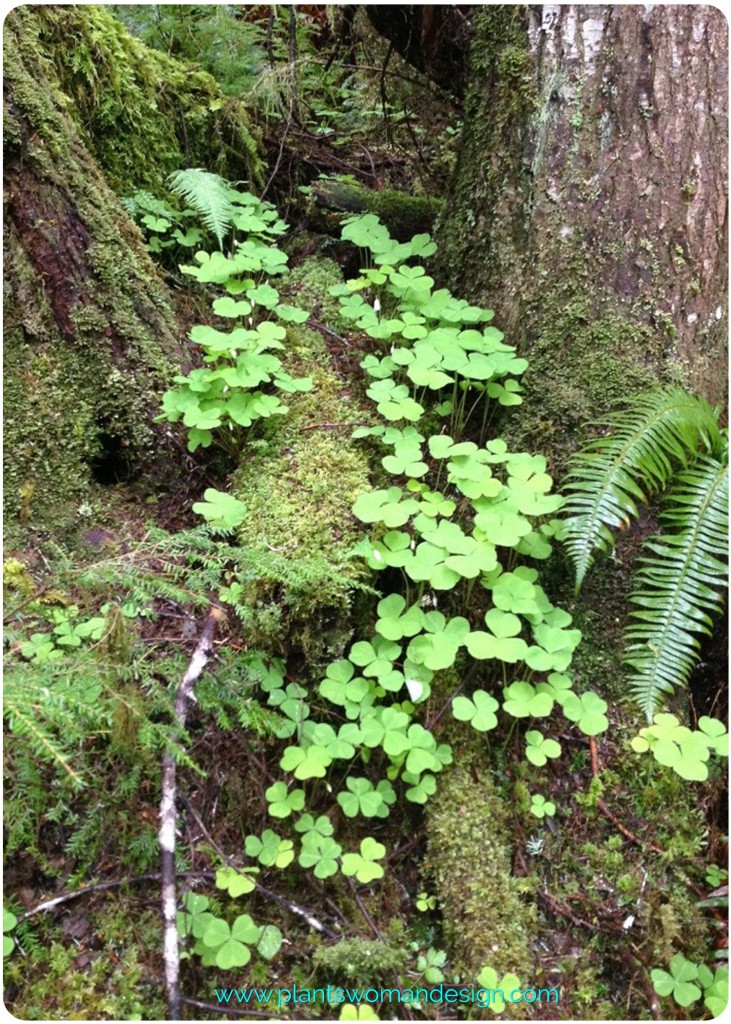
The contrast between hard and soft and dark and light is everywhere. The fresh green pops with the darker colors of decaying wood on the sides.
Few designers can make this happen ‘in captivity’.
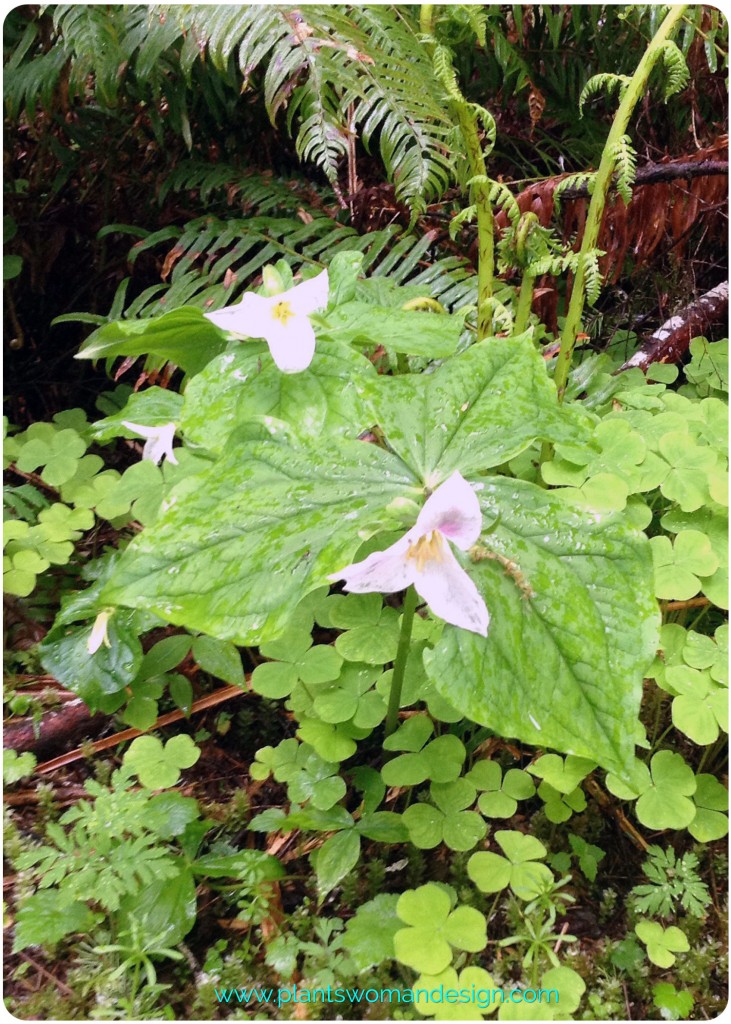
Native Trillium grandiflorum (Wake Robin), Oxalis oreganum (Wood Sorrel), tiarella cordifolia, (foam flower), and Dicentra formosa (bleeding heart)
Check out the recipes here at Wild and Slow (click on the link and then choose the wild edible you want to explore, e.g. wild sorrel). Sorry I sometimes get distracted by other posts from other lovers of things that grow wild.
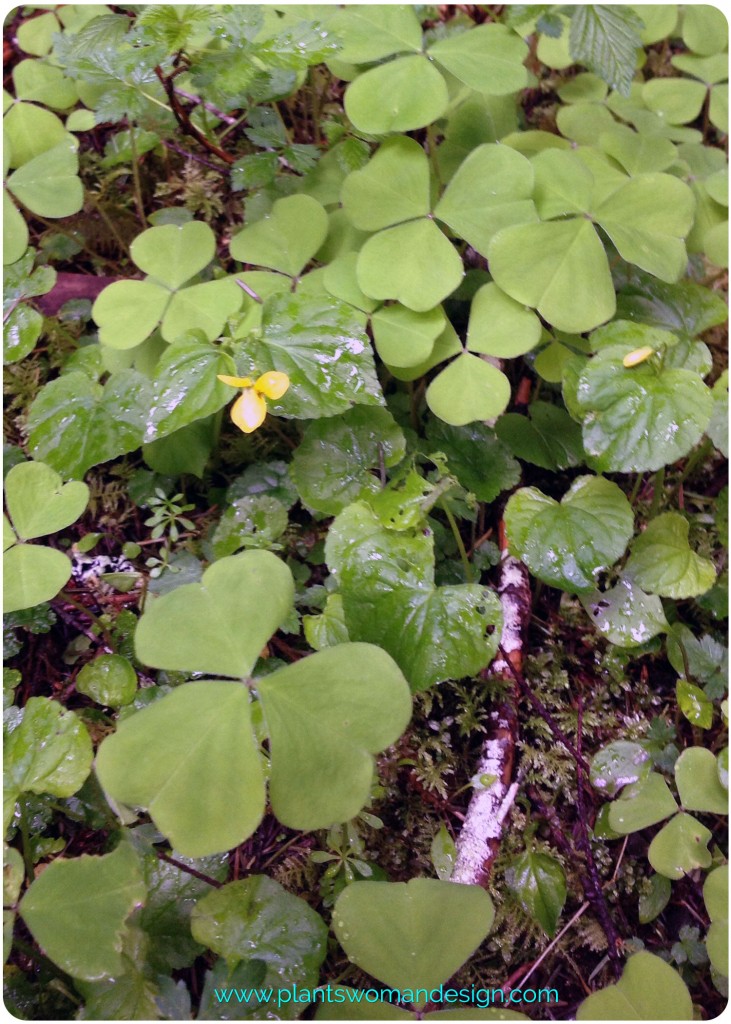
Small wood violets (viola orbiculata) with rain drops.
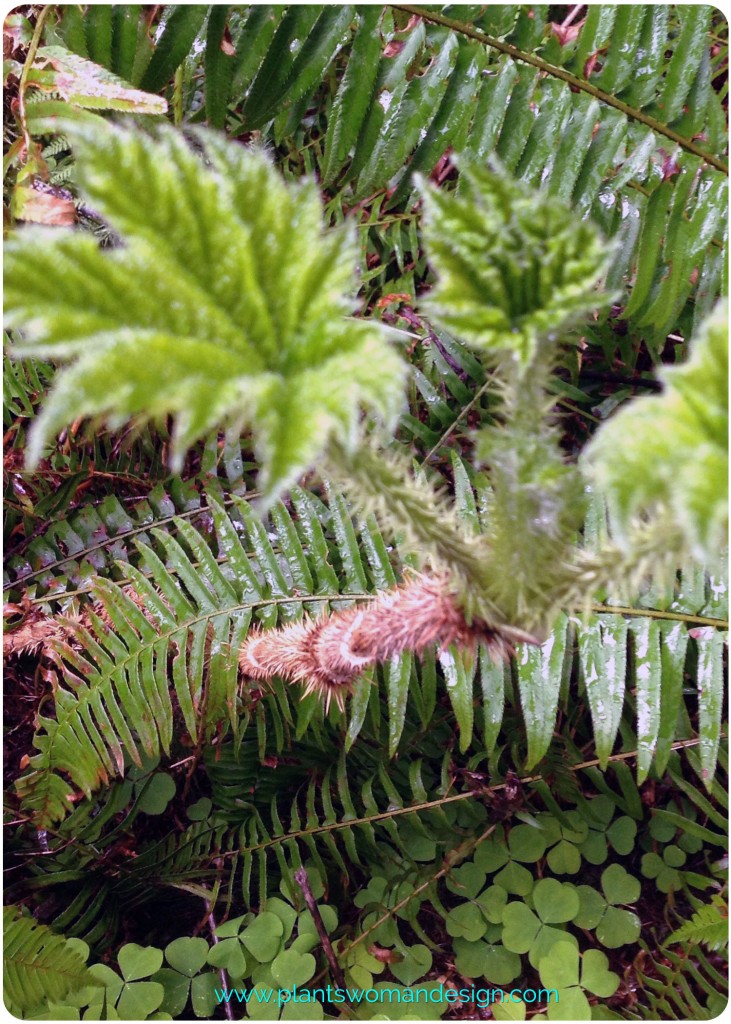
Devils club (Oplopanax horridus)
Even Devils club (Oplopanax horridus) looks lovely and soft this time of year.
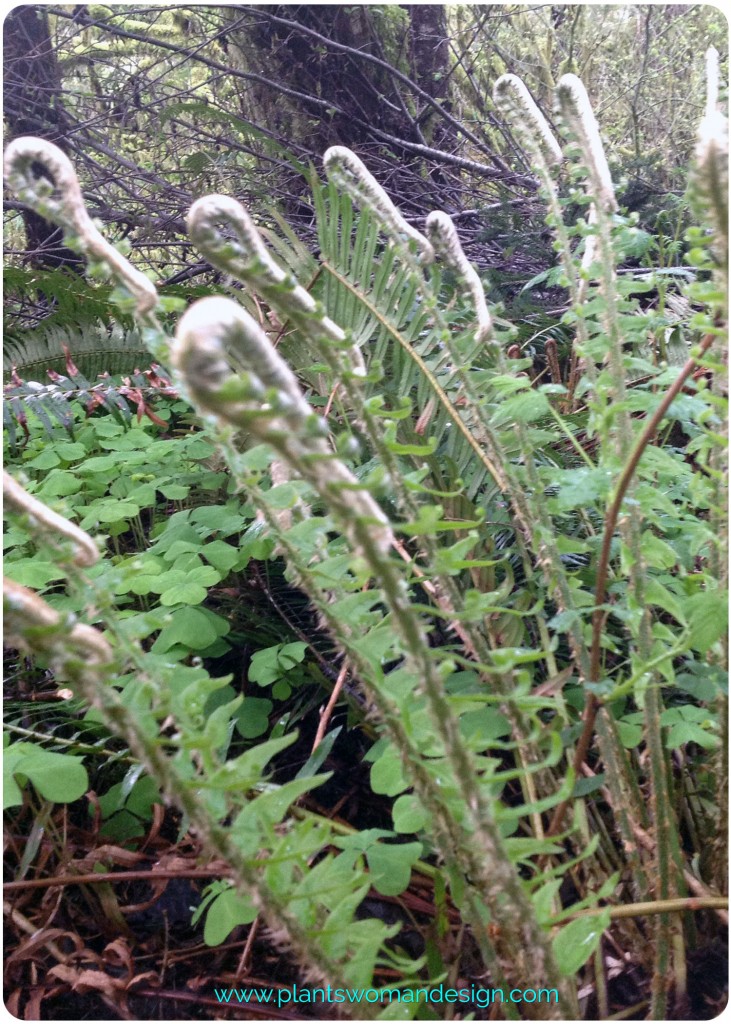 The Ferns are just unrolling and sending up sharp spires of green with soft fuzz on the stalks.
The Ferns are just unrolling and sending up sharp spires of green with soft fuzz on the stalks.

One of the most amazing things as I left the accounting world and started my own design business is that Spring happens one day at a time. I was amazed to see every day something new happening. Many of us (and me at that time) look up from the computer (desk, cash register, book, etc) and say ‘Wow, how beautiful! It’s Spring” . When really it happened just a little more yesterday, last week, and the week before that. If you find yourself being surprised by Spring’s sudden appearance I encourage you look a little closer, a little sooner, and a little more often. The beauty that surrounds us gives us the spark that makes each day worth living and it’s just waiting for us to see it.
Today’s challenge… Get outside today and take a snapshot of the beautiful nature around you. Send it to us at info(at)plantswomandesign(dot)com, we would love to see it!
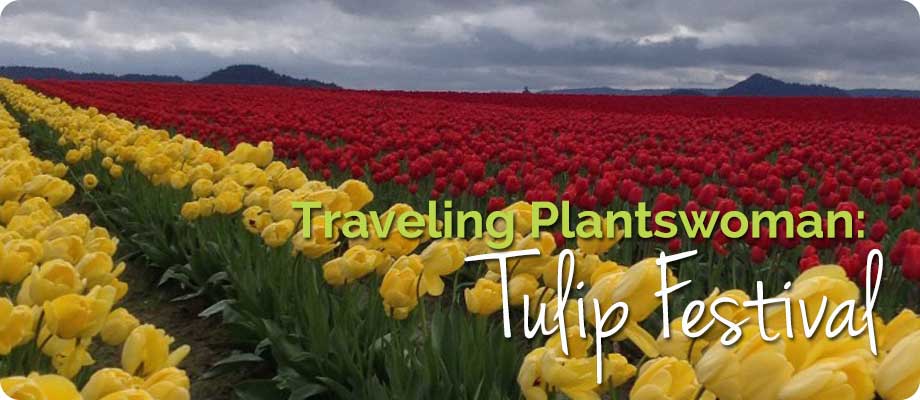
by Susan | May 2, 2014 | Traveling Plantswoman
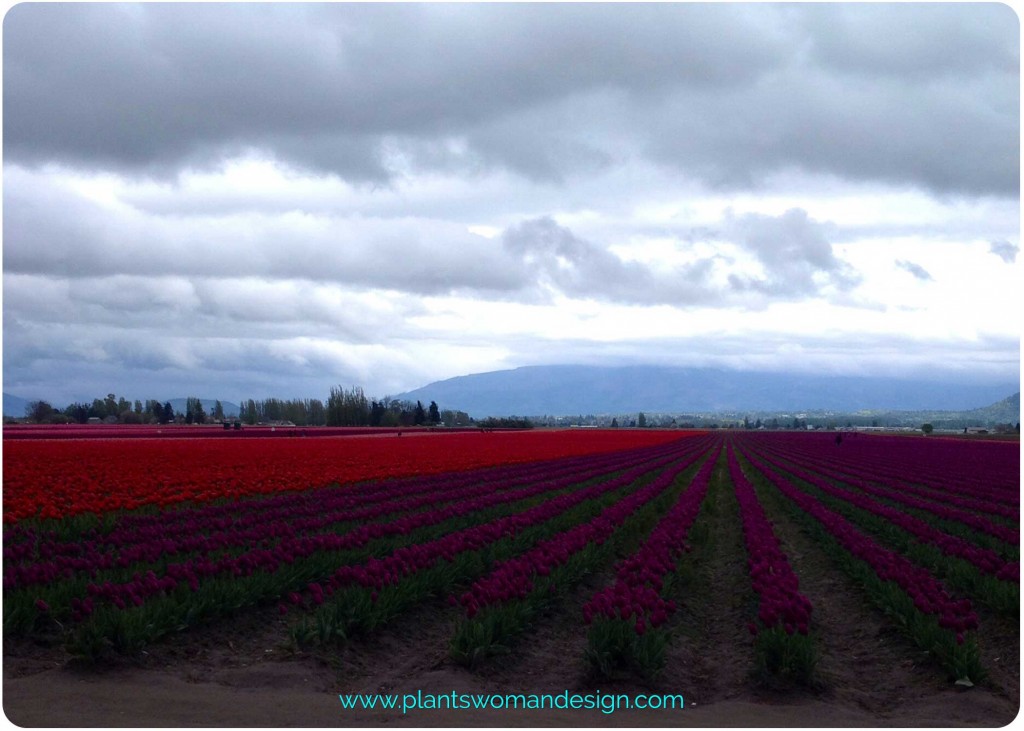
Sometimes people ask me ‘where do you get inspiration?’ I would have to say I go back and reconnect with the reasons I became a Landscape Designer in the first place. The wonder of spring, the fall colors, the cold winter with blooms still in evidence, the contrast between warm, cool and everything that happens in the middle. All of these things inspire me.
This past weekend I went to La Conner Wa to view the tulip fields. I have not been for a long time and they were FULL of people of many nationalities wandering through the fields enjoying the cool weather and the color. Oh, the color! It still amazes me that the growers don’t just throw the bulbs in any old way but intentionally plant the fields for color and contrast. For those of us who know nothing about the system, the color we see now is short lived. After they have bloomed they get the tops cut off and stay in the ground with leaves generating energy for big plump bulbs. I made the mistake of going the week after the festival one year to beat the crowds just to find no color.
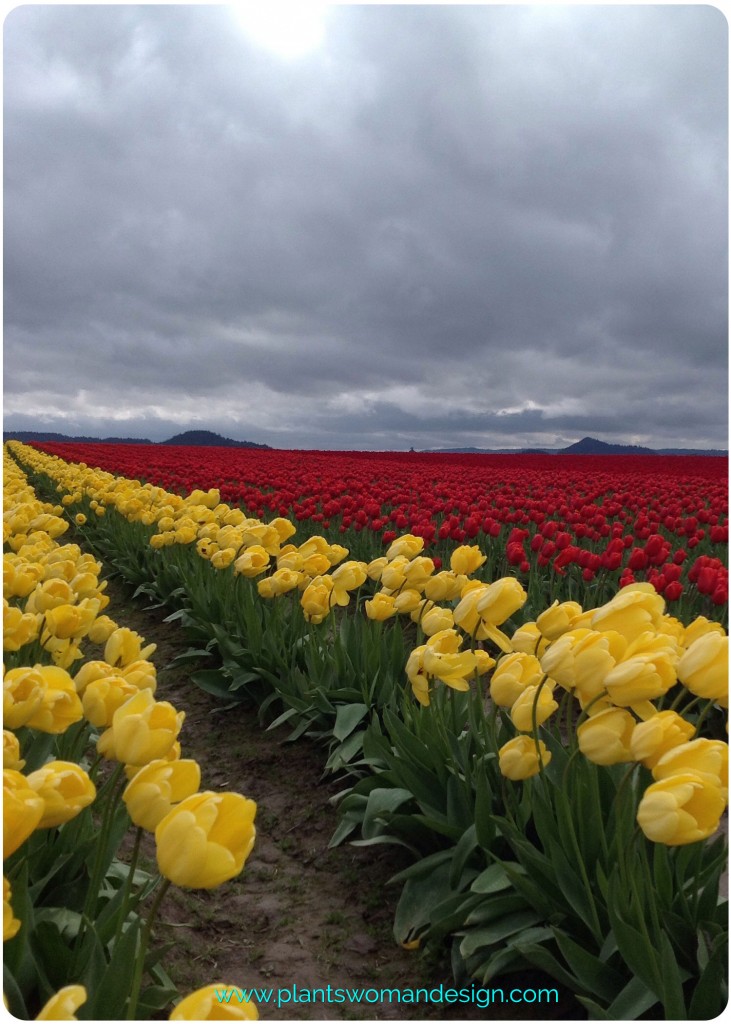

The Roozengaarde display gardens are truly beautiful. Full up with new varieties being tested it’s a good place to see new colors, shapes, and combinations.
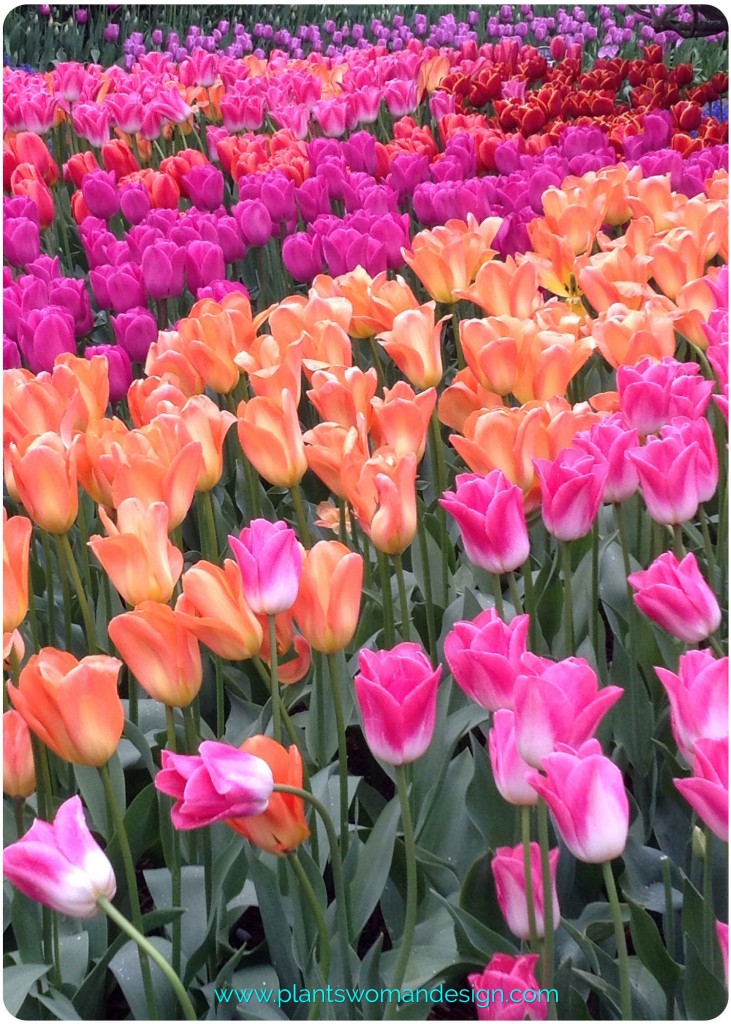
Roozengaarde Display Garden

Roozengaarde Display Garden
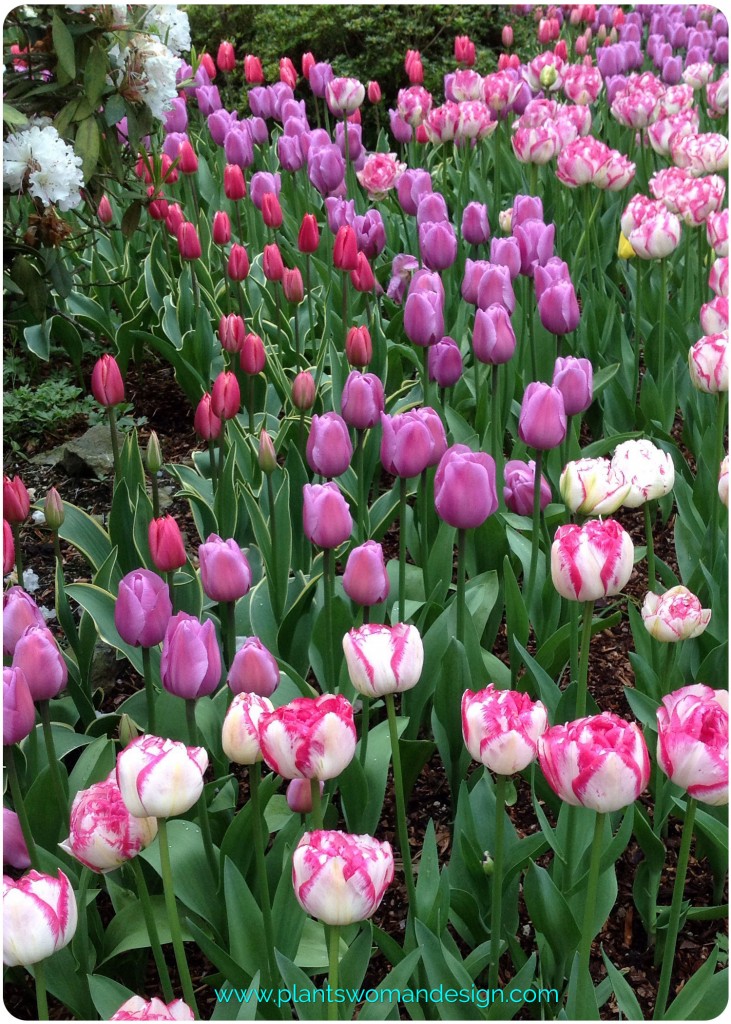
Roozengaarde Display Garden

Roozengaarde Display Garden
You can check out all the varieties of these gorgeous bulbs on line at www.tulips.com. Order now and they are delivered next fall. Believe me the varieties do sell out. I have ordered bulbs online from other companies and they have not been successful. At the Northwest Flower and Garden show this year one of the other gardens had bulbs from Roozengaarde and they were amazing.
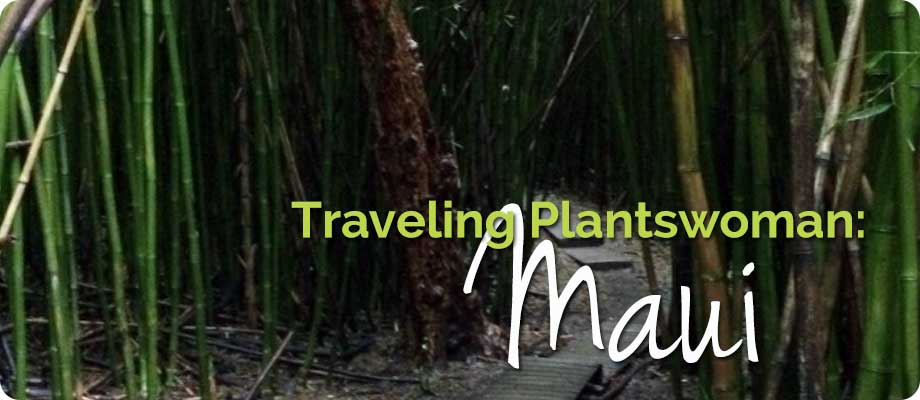
by Susan | Apr 13, 2014 | garden travel
After the Northwest Flower and Garden Show each year I want to relax. I usually try and schedule a vacation. The show is a hard act to follow so I have to choose wisely. I try to build on the feeling of spring that I felt at the show. This year that meant Maui.
I have heard lots of hype about this place and lots of negative comments about the amount of tourists and traffic. There are a lot of tourists and lots of tour busses. However, the places I go are usually away from crowds, hard to get to, or of little interest to most tourists. Botanical gardens barely receive a mention in the guide books. Hiking to beaches, waterfalls, and arboreteums are not for the usual tourist.

I usually pick up a couple of specific plant books about the area and bring my ‘Hikers Guide to Trailside Plants in Hawaii’ (John B Hall). The climate of the Hawaiian Islands are so friendly that many many plants brought from other places escape and grow with wild abandon in Hawaii. The trails are a botanical wonder for diversity of plants from all regions of the world. One of the books I bought was ‘Maui’s Floral Splendor” by Angela Kepler. This book has good content and a warning about the invasive plants strangling Maui’s natural areas. She and several other sources say to wash boots and equipment after hiking anywhere on Maui. This is to help stop the spread of seeds from one infected area to others. But I will save that for another time, (maybe a HHT).
I visited ‘The Garden of Eden’. It is a private botanical garden that is off of the Hana Highway. I was not very impressed by the collection of plants. They were not very well marked and not in the abundance that I’m used to seeing. There was however a very cool collection of Bamboo.
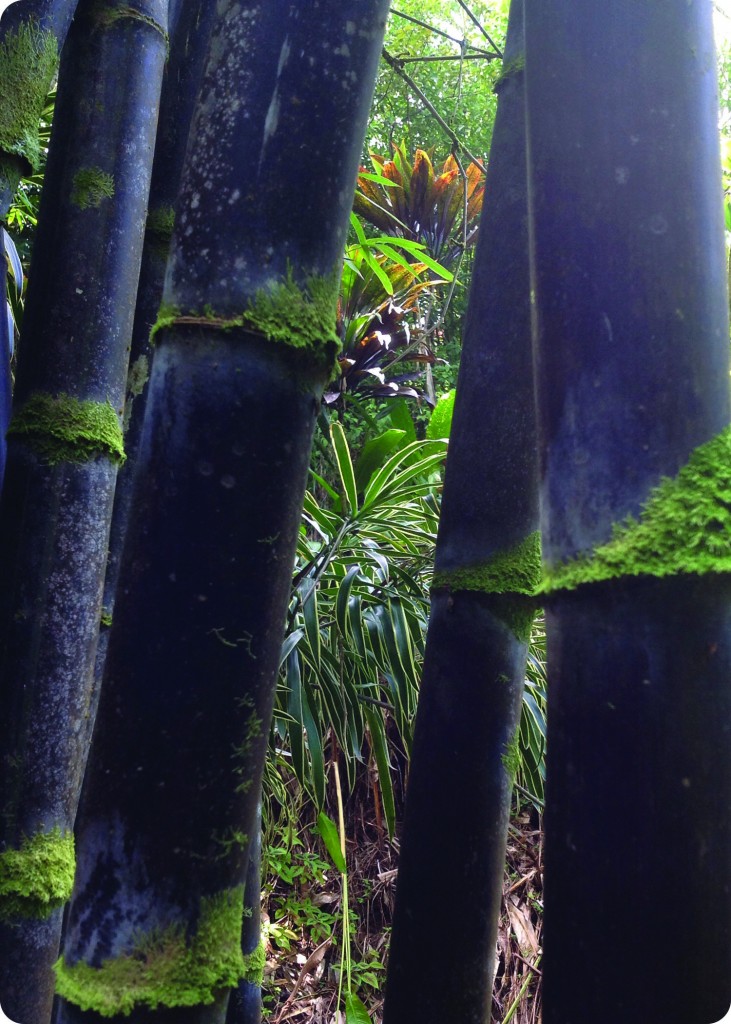
I love this dark black with a little mossy edge. It is Bambusa lako ‘Timor Island’ or Timor Island black bamboo and gets up to 60 feet tall.
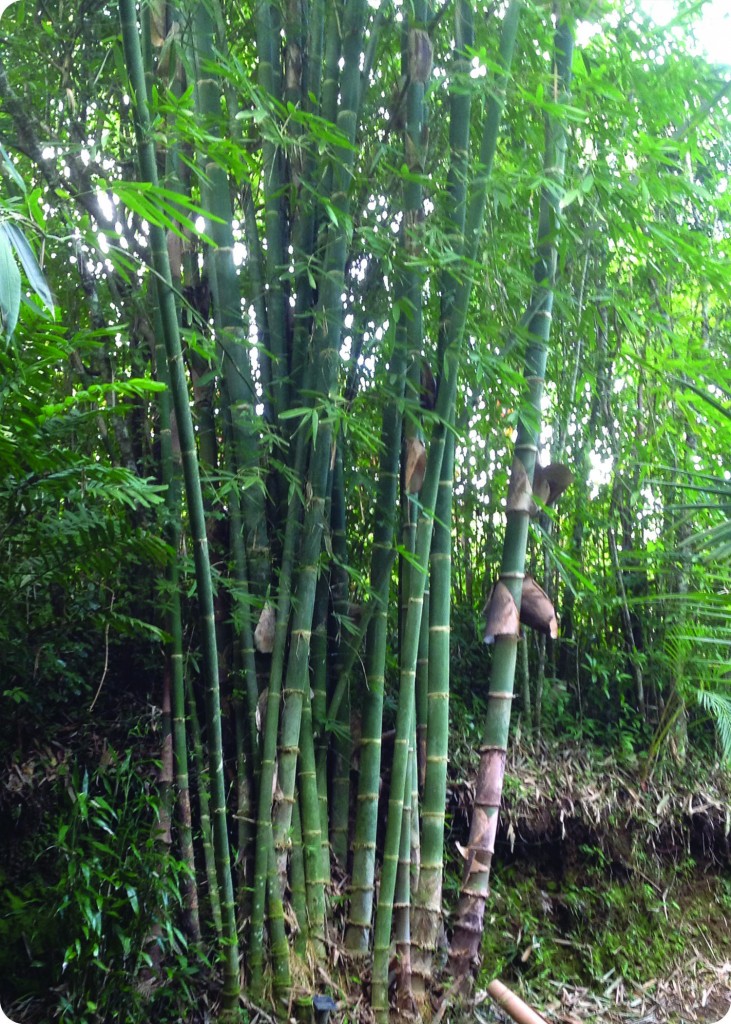 This one is giant about 50 feet high and about 6 inches in diameter.
This one is giant about 50 feet high and about 6 inches in diameter.
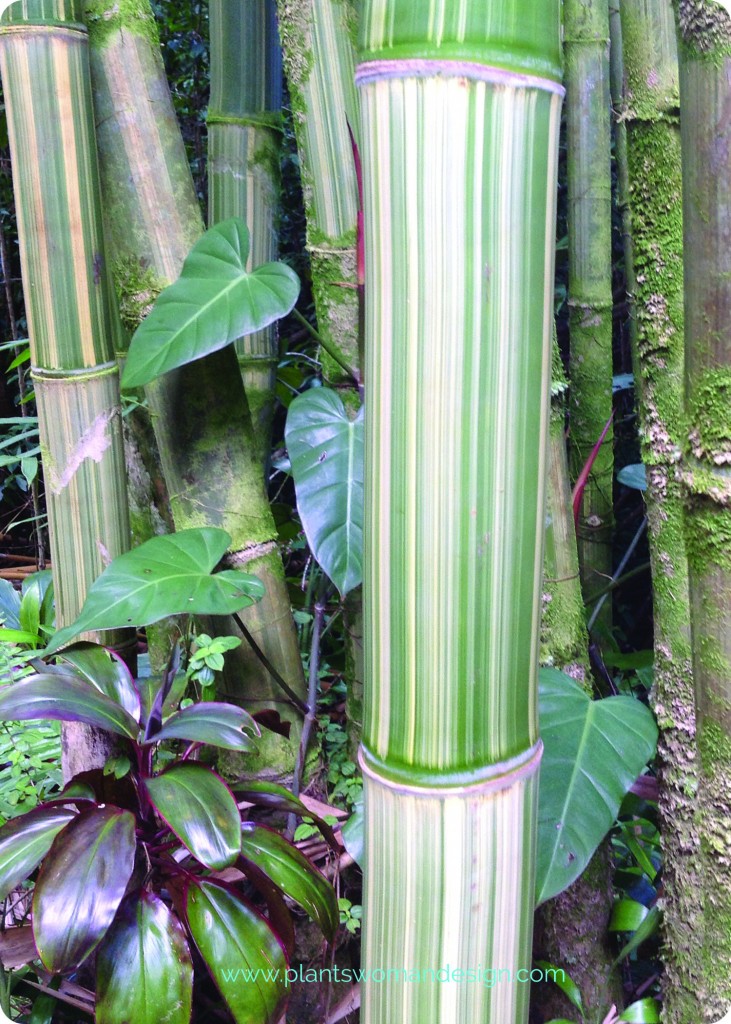
This is so great with lovely green and white stripes.
This of course was not enough bamboo…. so off to the bamboo forest. This is near Hana at the Haleakala National Park. We took a trail that goes beside the ‘Seven Sacred Pools’, across the road and follows the stream up through the bamboo forest. So cool!
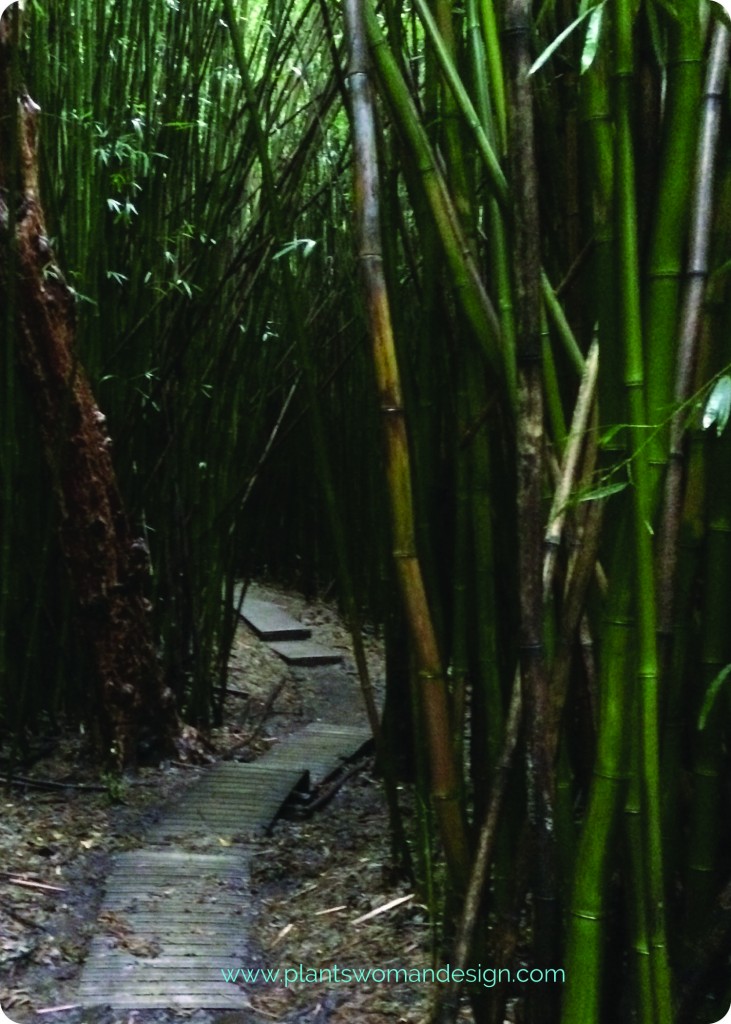
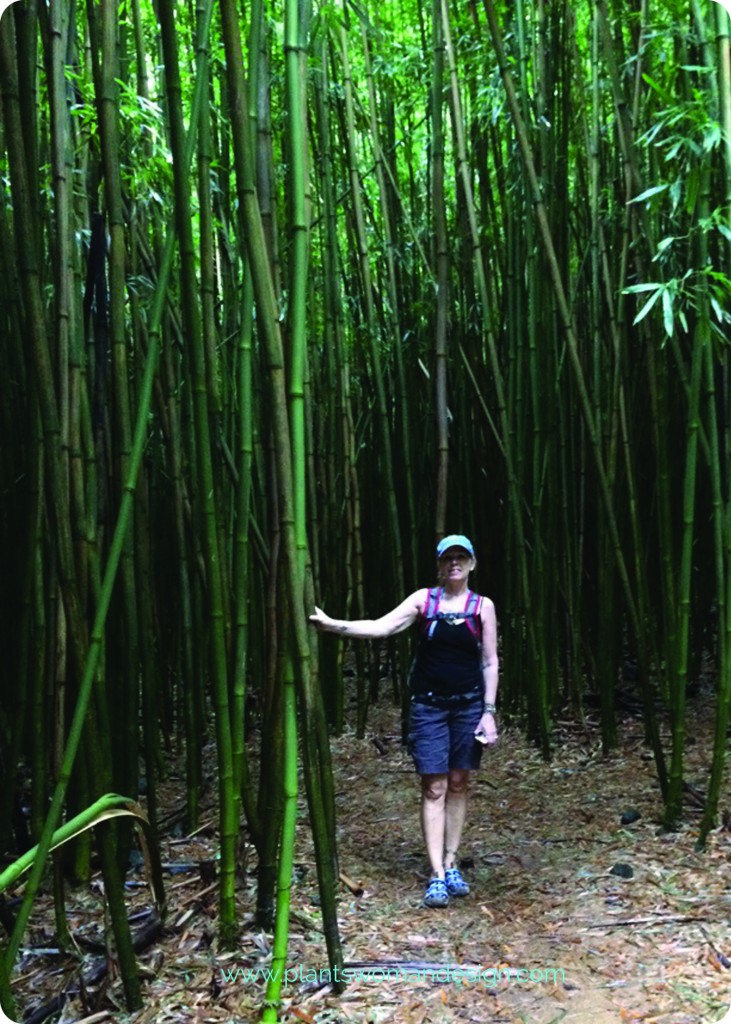
The bamboo overhead was a little intimidating as it moved in the wind. It gave off a spooky sound with clacking like one of those bamboo wind chimes only giant. Bamboo was definitely one of those visiting plants that came to stay. There are vast forests of bamboo that cover the hillsides.
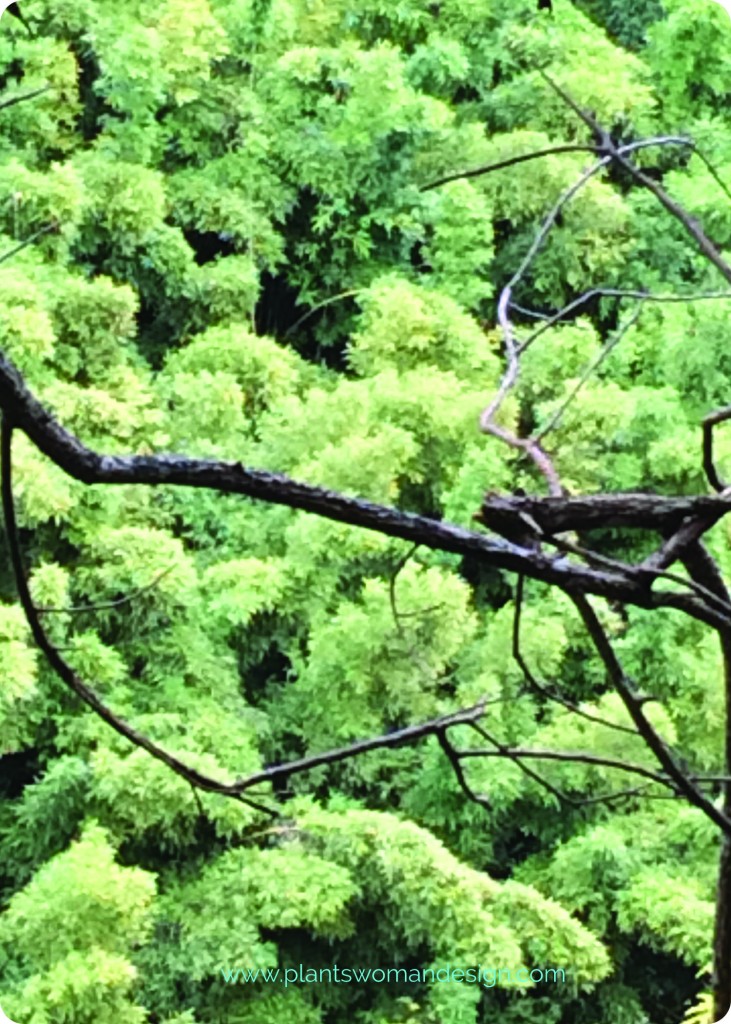
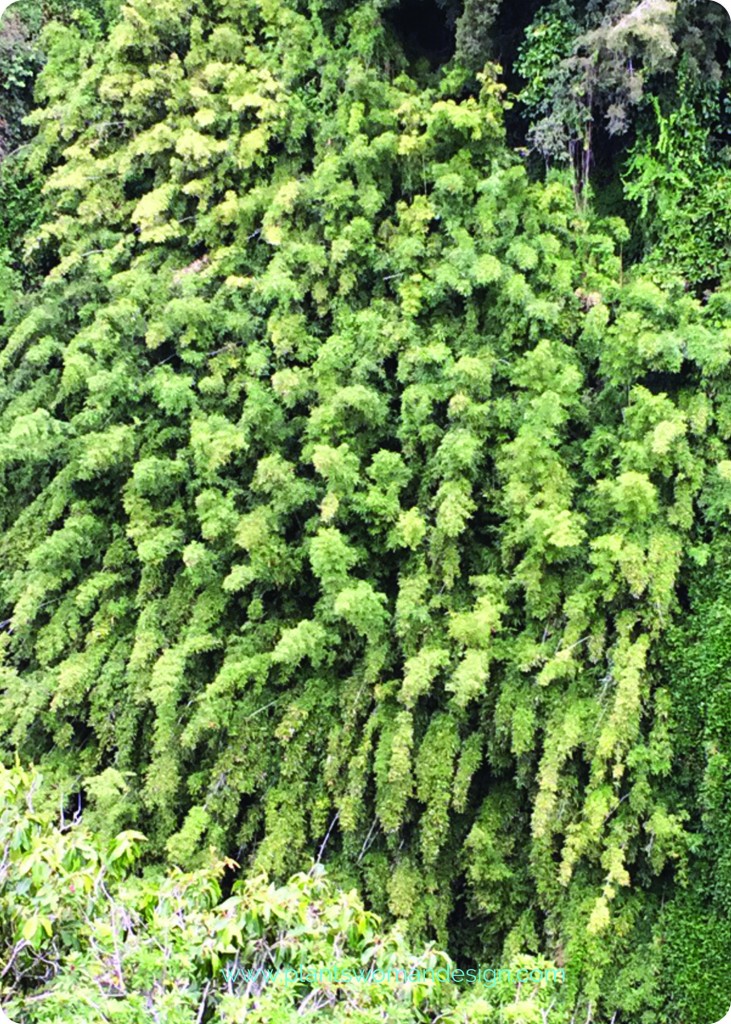
Of course at the end of the hike is a great waterwall. In fact there were three, with water dropping in a free fall not just meandering down the rocks.
 All in all the trip was great. I came back refreshed and ready to jump into the spring work that was awaiting my return.
All in all the trip was great. I came back refreshed and ready to jump into the spring work that was awaiting my return.
by plantswomandesign | Sep 13, 2013 | garden travel
There is a lovely spot just between summer and true fall when the air is slowly cooling and the fierceness of the sun is less effective. It’s a great time to hike into the woods and see nature’s garden. I am inspired by what I see in the natural world time and time again. The suddenness of color interspersed into soft neutral tones of the woodland is so amazing. As I see these I think of artist, Andy Goldsworthy. He works with natural found items and creates lovely temporary sculptures in the same way. Sometimes he puts bright leaves into muted backgrounds by creating patterns that are visible from a good distance away. This punctuation or ‘shout’ of color is really very art worthy.

I came across these amazing fungi while walking in the Blue Hills just outside of Boston. I know that in just a few weeks the woods will be vivid with the blazing New England colors of fall but right now there is a subtle beauty to see. Even along the coast of Cape Cod there are signs that the fall is approaching.
Walking and touring around the countryside helps me remember some of the basics of landscape design. Repetition of plants to bring the garden together and make it cohesive. A focal point that brings a statement of color to view. Soft harmonies in plant material color and texture can bring calm into the space . These are sometimes called ‘naturalist design principals’ for obvious reasons.
I’d love to hear from you. How are you noticing the coming of Autumn?
by plantswomandesign | Jul 20, 2013 | garden travel
It is always fun to play hooky. I sometimes refer it to running away from home. Since my business office is in the basement of my house that literally means leaving work and doing something else.
This last thursday I ran away from home to the Elisabeth C Miller Botanical Garden in Seattle. I have never been before but I will go back again. It was wonderful to see 3 acres of beautiful gardens, with shade and sun, conifers, and succulents, and most things in between. Our guide was one of the head gardeners Kelly. She did a really great job of directing us around the garden. I loved the fact that she knew many plants but not all of them, and was not afraid to admit it. I believe that we plant people are always learning too. These are not all great pictures but will give you a sense of my exploration and perhaps inspire you to visit too. It was a rare hot sunny day.

Garden path around house

Lovely weeping yew

hardy orchids in the bog garden
![]()
great plant combination

weeping camellia
If you get a chance to visit do. Only 500 visits per year are granted. I would love to go back in the fall. The mature trees will possibly be brilliant with color.
It, like all gardens, will change through the years. Trees need to be removed, winter damage, drainage issues, and plant purchases. This keeps the garden alive with new spaces and plants. I love to remind my clients that gardens are not like your living room. When you buy a new couch it is beautiful but stays the same. A plant on the other hand will grow, mature, blossom, have fragrance, fall color, winter interest, will spread, even sometimes have a sport or cross pollinate with another plant and create a new hybrid. I love that about gardens Elisabeth Miller endowed the garden so that new plants could be added as if she were still alive.
Check out their website for more information. Miller botanical garden
by plantswomandesign | Jul 5, 2013 | garden travel, gardening, Traveling Plantswoman
While photographing window boxes I also came across some great small courtyard gardens, Boston has such great old buildings. There are shared spaces between the houses (squares) that have huge old trees and places to gather. Often grass and benches, sometimes with shrubs to provide privacy. These are all the garden that some of these houses have access to. Several of the bigger houses had courtyards in front of them and many were wonderful serene small garden spaces.

This garden has a lovely sitting area for the times when, even though there can’t be much sun with the tall buildings on either side, it is warm enough to sit outside. The days were hot while I was there and evenings were lovely and warm with no coat needed.

Most of these fabulous gardens were fenced off from the street with ornate black iron fences. This area of Boston, just beyond Boston Commons, is one of the oldest in the city. Originally an area where statesman and writers lived it is now home to a variety of families along with some long time wealthier residents.

The details in this garden are lovely in their simplicity. The use of repeated white and green in the flowers and leaves along with the specimen arisaema and other unusual plants give it a calm quiet respite. It has a sophistication in planting that is in keeping with the house while not being busy. I will have to say I saw so many lovely hostas without any holes in them I’m thinking they don’t have slugs or snails there.

There are a few splashes of pinky red that stand out. The tri-colored beech- fagus sylvatica ‘Argenteo Marginata’. with Athyrium niponicum pictum, Japanese painted fern was stunning in the soft rain soaked air. A soft fuzzy light was filtering through the clouds and rain to make the pictures soft and fuzzy also.

Even very small spaces can entice a gardener to dig in the dirt.

The streets are narrow in this area also with very little parking and permits required for residents. There was the feeling of hushed quiet just a few steps from the bustle of downtown. This is one of the famed cobblestone streets.

I spent a great deal of time walking in Boston. It is a great way to see the city, meet people, and get a sense of the surrounding gardens and neighborhoods you walk through. Do you think you could live in a large city like this? Would you have to have enough space to garden?

 Remember the blog post from this past spring when I visited the tulip fields in Mt Vernon? They had the most spectacular display gardens, I took lots of pictures, you can read about it HERE. Now is the time to order. September through December you can pick bulbs from the list at www.tulips.com and they will send them off to you. I was not ready to pre-order last spring because I didn’t know where I was going to be. Now I’m ready and I’m going back through the pictures I took to get the labels. If I find a tulip I like I take a picture of the tulip up close and then a picture of the label. I try to always keep them in order so I can see which goes with that but it isn’t hard to figure out if you get mixed up. They have lots to choose from. Remember deer love tulips so if you have lots of 4 hoofed friends choose either daffodils (narcissus) or Allium bulbs. They are not on the favorite food list.
Remember the blog post from this past spring when I visited the tulip fields in Mt Vernon? They had the most spectacular display gardens, I took lots of pictures, you can read about it HERE. Now is the time to order. September through December you can pick bulbs from the list at www.tulips.com and they will send them off to you. I was not ready to pre-order last spring because I didn’t know where I was going to be. Now I’m ready and I’m going back through the pictures I took to get the labels. If I find a tulip I like I take a picture of the tulip up close and then a picture of the label. I try to always keep them in order so I can see which goes with that but it isn’t hard to figure out if you get mixed up. They have lots to choose from. Remember deer love tulips so if you have lots of 4 hoofed friends choose either daffodils (narcissus) or Allium bulbs. They are not on the favorite food list.















































